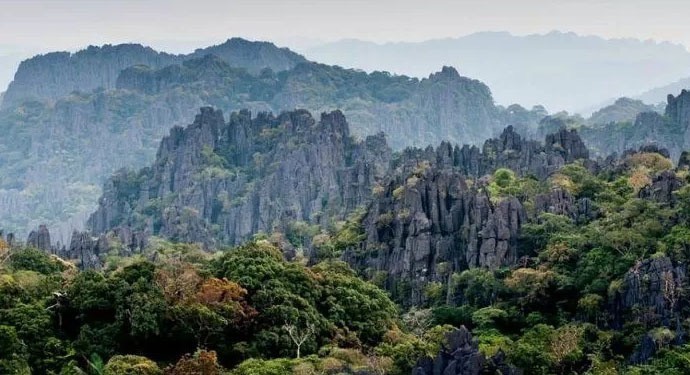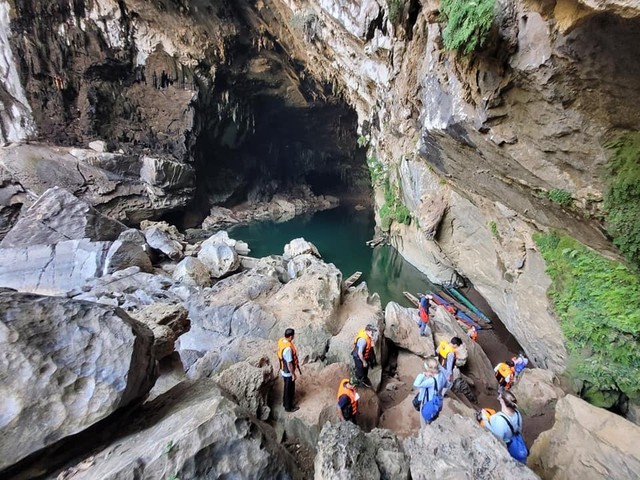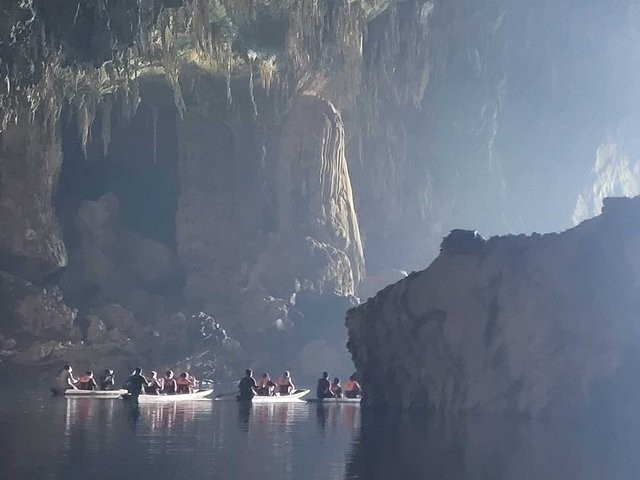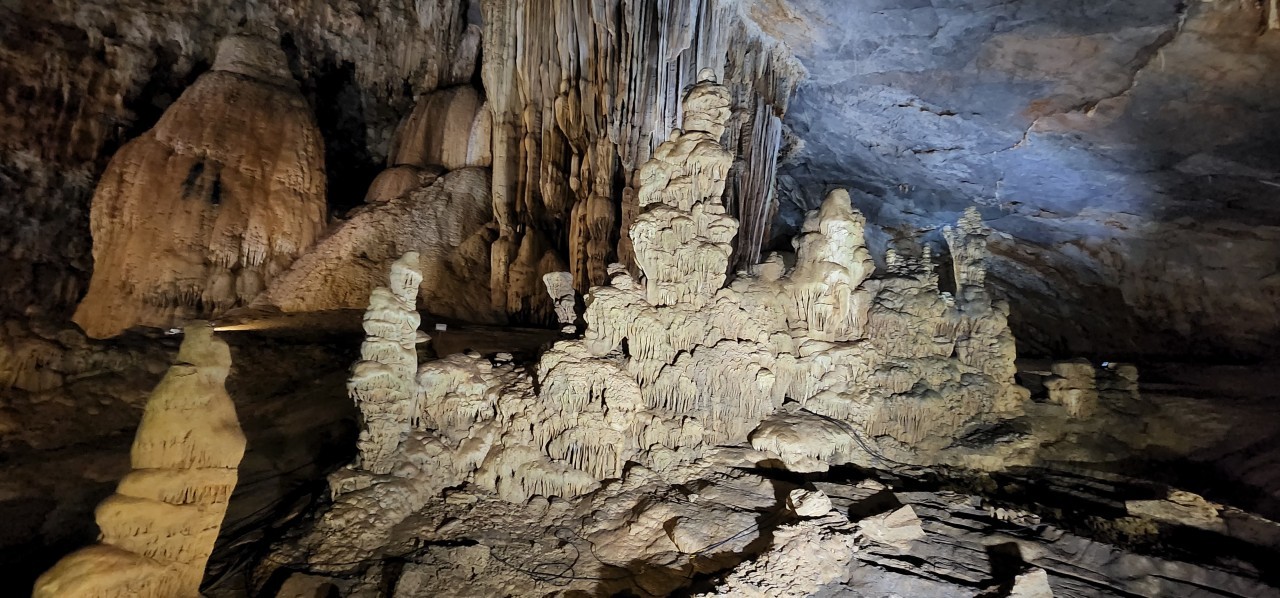IUCN Promotes Cooperation in Cave Tourism Between Vietnam-Laos
IUCN has organized a consultation meeting on the transboundary management framework between the two national parks of Phong Nha - Ke Bang and Hin Nam No.
 |
| Hin Nam No National Nature Reserve in Bualapha District, Khammouane Province, Central Laos. (Photo: Thoi Dai) |
Potentials for cooperation
Prominent among them are rare species such as red-shanked douc and white-cheeked langur, Vu Quang barking deer, harlequin bat, great hornbill, sooty babbler... In addition, Hin Nam No Reserve also has great potential for natural tourism with a beautiful limestone cave system including Nangen cave, King cave, Konglor cave, and Xebangpha cave.
Hin Nam No and Phong Nha - Ke Bang are two areas adjacent to each other, contiguous by a system of limestone mountains on the border of Vietnam – Laos. Therefore, a common management mechanism for the two National Parks is very necessary to exchange information and share experiences in patrolling and protecting forests, conserving biodiversity, and developing livelihoods and tourism for both sides.
Kamonrat Chayamarit, UNESCO Representative in Thailand and Laos shared: “During the application process, realizing that this is a cross-border extension, the World Natural Heritage nomination dossier will need a transboundary management framework developed by IUCN, through which the two national parks can communicate, coordinate and collaborate to ensure effective protection of Outstanding Universal Values (OUV) of both sides”.
With similar advantages in tourism resources, and favorable geographical location between 2 national parks, 2 provinces of Kham Muon (Laos) and Quang Binh (Vietnam), it is necessary to have connection and cooperation to form common tourism products, supporting each other to promote and attract tourists between the two provinces and international visitors, especially tourists from markets with high spending ability and long stay such as Europe, North America.
Hin Nam No Nature Reserve is in the process of finalizing its nomination dossier as a World Natural Heritage Site to UNESCO, by becoming a transboundary extension of the Phong Nha – Ke Bang World Natural Heritage Site. If successful, this will be the first World Natural Heritage site in Laos. When combined with Phong Nha - Ke Bang, it will have a total area of 217,000 hectares, forming one of the largest Karst (limestone) conservation areas in the world.
 |
| Tourists prepare to explore caves at Hin Nam No nature reserve (Laos). (Photo: Thoi Dai) |
Phong Nha - Ke Bang & its value in Vietnam's natural reserve
Phong Nha - Ke Bang is a national park of Vietnam with an area of more than 123,000 hectares, located in Bo Trach and Minh Hoa districts of Quang Binh province in central Vietnam. This place is featured with numerous limestone formations, more than 300 caves, underground rivers, and rare flora and fauna listed in the Vietnam Red Book and the World Red Book.
Phong Nha Ke Bang National Park was recognized by UNESCO twice as a World Natural Heritage for its outstanding global values of geology, geomorphology (in 2003), and biodiversity (in 2015).
 |
| Sebangphai cave (Kham Muon - Laos) has similarities with the cave system in Phong Nha - Ke Bang. (Photo: Thoi Dai) |
The Phong Nha-Ke Bang National Park coveres 85,754 hectares. With this extension, the site covers a total surface area of 123,326 hectares (a 46 % increase) and shares a boundary with the Hin Namno Nature Reserve.
The Park’s landscape is formed by limestone plateaux and tropical forests. It features great geological diversity and offers spectacular phenomena, including a large number of caves and underground rivers. The site harbors a high level of biodiversity and many endemic species. The extension ensures a more coherent ecosystem while providing additional protection to the catchment areas that are of vital importance for the integrity of limestone landscapes.
The property contains and protects over 104 km of caves and underground rivers making it one of the most outstanding limestone karst ecosystems in the world. The karst formation has evolved since the Palaeozoic period (some 400 million years ago) and as such is the oldest major karst area in Asia.
Subject to massive tectonic changes, the karst landscape is extremely complex, comprising a series of rock types that are interbedded in complex ways and with many geomorphic features. The karst landscape is not only complex but also ancient, with high geodiversity and geomorphic features of considerable significance.
A large number of faunal and floral species occur within the property with over 800 vertebrate species recorded comprising 154 mammals, 117 reptiles, 58 amphibians, 314 birds and 170 fish. The property clearly has impressive levels of biodiversity within its intact forest cover, notwithstanding some gaps in knowledge of the population status of some species. .
 |
| The masterpieces of nature in Phong Nha - Ke Bang. (Photo: Thoi Dai) |
Hin Nam No National Nature Reserve - Home to diverse faunal and floral species
Hin Nam No National Nature Reserve is located in Bualapha district, Khammouane province in the central of Laos. As a large limestone mountain complex, with a total area of more than 82 thousand hectares, Hin Nam No is home to many animals and plants including 40 species of mammals, more than 200 species of birds, 25 species of bats, 46 species of amphibians and reptiles, more than 100 species of fish and more than 520 species of plants.
The characteristic landscape style of the Hin Nam No karst is that of a dissected plateau of karst massifs that are bordered by bare limestone walls or cliffs rising up to 500 m above intervening alluvial plains and flat-bottomed basins, known locally as kouans. The limestone massifs have been dissected by karst processes into polygonal karst relief, with deep depressions (cockpits) surrounded by residual conical hills (fengcong).
White most of the area is forested, bare rock surfaces on the massifs and fengcong have frequently been eroded into sharp and spectacular pinnacles. The Xe Bang Fai River has cut a 6.4 km underground course through the limestone karst, creating the largest active river cave passage in the world, which is superbly decorated with many large and beautiful cave formations.
Hin Nam No NPA is considered of outstanding universal value (OUV) based on the development of its complex and spectacular karst landscape, significant on-going biological processes especially évident in speciation events within surface and subsurface karst ecosystems, and its wide variety of pristine habitats supporting high biodiversity, including a number of globally threatened species, endemi species and karst specialist species.
 | Festival Held For Vietnam, Laos and Cambodia Children Children from Vietnam, Laos and Cambodia gathered at a cultural exchange in Ho Chi Minh City on August 10, which is hosted by the Central ... |
 | Fifth Conference of Justices of Border Provinces of Vietnam and Laos Held The fifth court conference among the border provinces of Vietnam and Laos officially opened to discuss measures to further strengthen their judicial cooperation. |
 | Celebrating Mid-Autumn Festival on the Vietnam-Laos Border The Quang Tri Border Guard had a good way of coordinating the mass organizations, benefactors organize for Laotian children and teenagers to have fun with ... |
Recommended
 Friendship
Friendship
Another Vietnamese University Partners with Germany’s Konrad Adenauer Stiftung
 Friendship
Friendship
Over 200 Vietnamese and Russian Children Join “Red Scarf Of Friendship”
 Friendship
Friendship
Venezuela Seeks Vietnam’s Expertise in Science and Technology
 Friendship
Friendship
Diverse Activities to Celebrate the 50th Anniversary of Vietnam - Germany Diplomatic Relations
 Friendship
Friendship
Dr. Vu Hoai Chuong Receives Hungary's Knight Cross Order
 Friendship
Friendship
Promoting Vietnam - Japan Economic Cooperation
 Friendship
Friendship
VUFO Attends Fourth Dialogue on Exchange and Mutual Learning among Civilizations
 Friendship
Friendship


